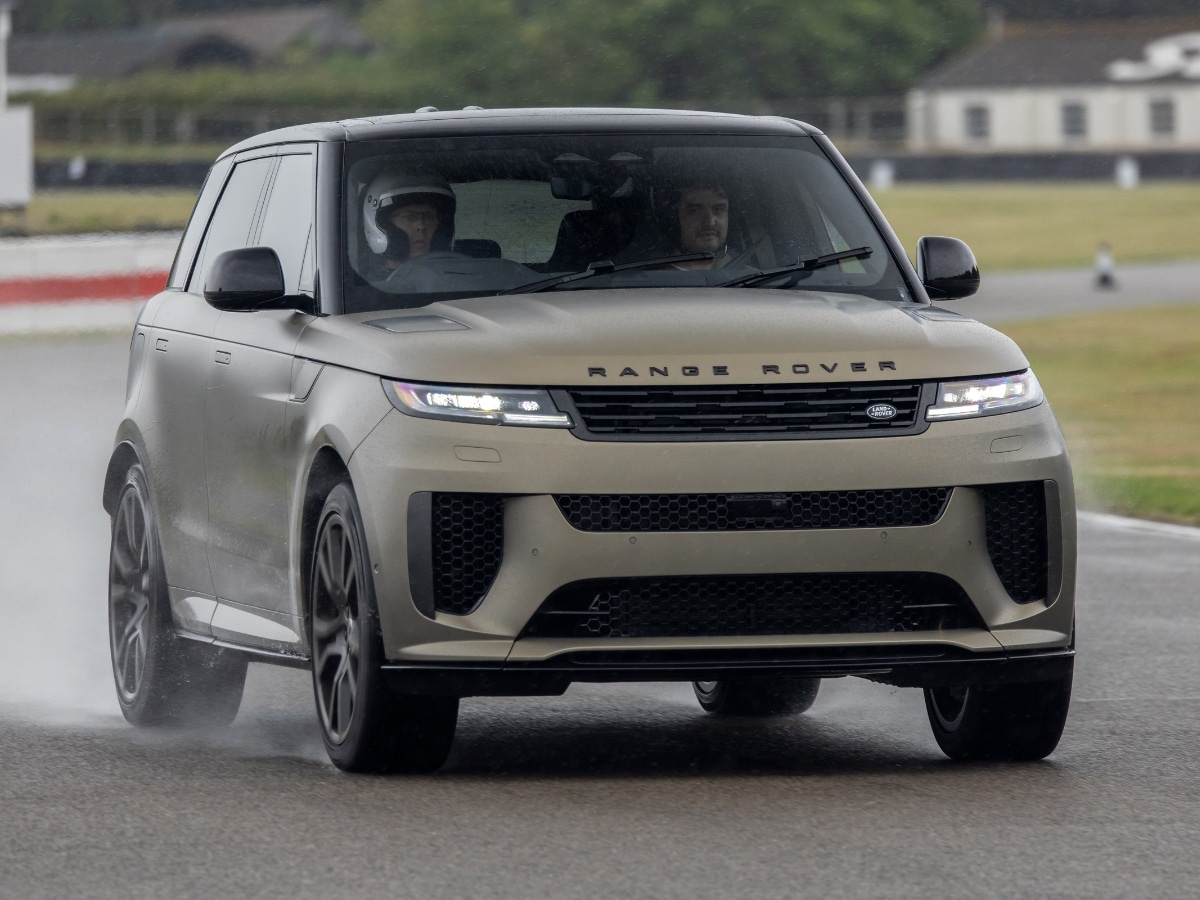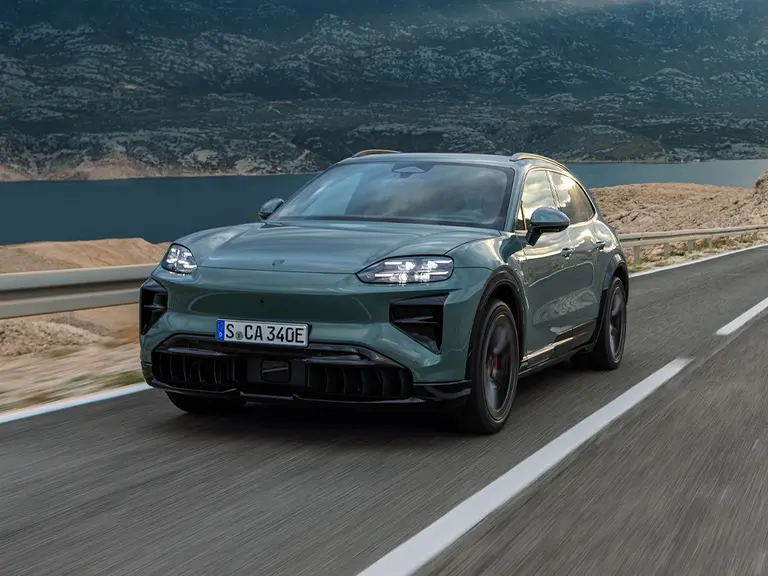
Published:
Readtime: 9 min
Every product is carefully selected by our editors and experts. If you buy from a link, we may earn a commission. Learn more. For more information on how we test products, click here.
Halo Car. Definition: A vehicle that goes out of its way to push technology, styling, and performance to the max in search of that which is beyond anything we’ve seen from the manufacturer before.
Example: The new Range Rover Sport SV. A vehicle that combines a fiery mild-hybrid 4.4-litre Twin Turbo V8, 6D Dynamic suspension with roll and pitch control, and seats that create a full body audio experience like nothing you’ve experienced in a car before.
The original Range Rover threw the rulebook out when it created a vehicle that combined luxury and offroad prowess together for the first time. We’re seeing this level of innovation again with the new Sport SV.
Jaguar Land Rover (JLR) wants you to forget everything you know about the Range Rover Sport as they push the idea of ‘box-ticking’ to the side and create a car that’s here to rewrite the rule book for performance SUVs. What the team at SV have created is a true halo car.
RELATED: 2023 Land Rover Defender 90 V8 is a Fantastic ‘FlexUV’.

Range Rover Sport SV is an Engineering Masterpiece
It all starts with the 6D Dynamics suspension. You’ll notice the car sits up to 25mm lower than other Sport models but that’s just the start.
The suspension is explained to me in great detail by SVO Chief Programmes Engineer at Jaguar Land Rover, Colin Kirkpatrick. He says the system controls not only the roll from side-to-side (without physical anti-rollbars) but also pitch front-to-back with dual-circuit hydraulic lines that run between the front and rear suspension to keep the car flat under rapid acceleration and deceleration.
With a benchmark figure of 2.5 degrees of pitch during 1G of lateral acceleration, the way the Sport SV accelerates is mind-boggling. For reference, most production cars struggle to get below 4 degrees of pitch per G of acceleration. And this is a 2.5-tonne SUV.
This system works together with an SV-specific tune setting across the Intelligent All-Wheel Drive, All-Wheel Steering, Torque Vectoring by Braking, Configurable Dynamics and Active Locking Rear Differential. It sounds like a bit of a mouthful, but the result is the driving experience of a sportscar.
The cherry on top is the electronically power-assisted steering that features the fastest steering ratio of any Range Rover to date.

Eight-piston carbon ceramic Brembo Octyma front brakes sit behind the world’s first 23-inch Carbon Fibre Wheel option on a production car. I’ve been told this saves 35.6kg of total weight from the car (most of which is unsprung), but on a car that weighs more than 2.5 tonnes, it’s mostly aesthetic. That’s fine by me.
I’m pleased to report the quad exhaust pipes are real and you can match your carbon fibre wheels with carbon detailing on the logo, front bumper blades, grille surround, bonnet vents, side vents, and the centre section of the carbon fibre bonnet. You won’t mistake this for your run-of-the-mill Sport.
Join Our Exclusive Community!
WINNER– Media Brand of the Year, 2025
WINNER– Website of the Year, 2024

What Powers the Range Rover Sport SV?
Simply put, the Range Rover Sport SV is the most powerful Range Rover ever built.
Gone is the Range Rover Sport SVR’s Supercharged 5.0-litre V8 with a new mild-hybrid 4.4-litre Twin Turbo V8 engine in its place. Power figures are up 44 kW and 50 Nm respectively, now sitting at a healthy 467 kW (635PS) and 750Nm, which propels the Range Rover Sport SV from 0-100 km/h in as little as 3.8 seconds using launch mode.
Even from the passenger seat on a wet Goodwood Motor Circuit, it was clear the SV was supremely quick. I can’t understate the speed difference between the old car (which managed 0-100km/h in 4.7 seconds) and the new car. In the world of fast cars, 1 second might as well be an eternity.

How Does the Range Rover Sport SV Drive?
I travelled to the United Kingdom for the Goodwood Festival of Speed to get a passenger ride in a pre-production Range Rover Sport SV at the Goodwood Motor Circuit. And while I’d usually struggle to give any driving impressions from the co-drivers seat, the wind, rain, and slippery track conditions meant it was best to have the racing drivers find the limits of this $400,000 AUD vehicle in the wet.
Accelerating out of the pits flat chat in the pouring rain was particularly impressive. With a combination of bespoke 285-section front and 305-section rear Michelin Pilot Sport All Season tires, All-Wheel Drive, and 6D Dynamics suspension to manage weight transfer, the 2560kg SUV propelled itself to the first corner.
We reached Madgwick Corner at pace, jumped hard on mammoth Brembo brakes, and the weight transferred over the nose of the vehicle with just the right amount of pitch. Too much and the back end would be doing its best to overtake us, too little and the car would surely understeer off the dry line and into the grass.
It managed the fast-flowing Fordwater right-handers perfectly, with only hints of lift from my driver to get the rear end rotating. Strong brakes again into St. Mary’s.
With a rear-bias setup in SV mode, it allows the driver to choose just how much oversteer (or understeer) you’d like in the mid-corner. Prod the loud pedal and the rear end gets lively. Crank the quick ratio steering and the front end will fight the tires for lateral grip. It’s very… sportscar-like.
It’s at this point that I’d tell you about the benchmark lap times that it’s set around the world. However, even though it spent 6 months testing at the Nürburgring Nordschleife circuit in Germany, a ‘Ring attack’ isn’t in the pipeline for the Sport SV. Would it beat a Lamborghini Urus Performante on the track? Probably not. But JLR sees this as an all-rounder. A mature car for successful people that want something that can do everything.

Range Rover Sport SV Brings the Excitement Inside the Cabin
If it wasn’t for all the extra space, you’d be forgiven for thinking you’re sitting inside a sportscar. Modern luxury is an understatement, with performance seats, a large touch screen Pivi Pro display, and the world’s first translucent edge-lit gear shift paddles nestled behind a steering wheel with more pronounced thumb grips.
Gone are the push-pull climate and seat heating dials which have been replaced by screen controls. Not my favourite move as they were a highlight of the cabin for me, but I’m pleased to say they actually work and they’re not hidden in menus.
Not forgetting this is a halo car, the seats introduce Body and Soul Seat (BASS) technology for the first time. Far from a simple party trick, it creates a multi-dimensional audio experience that allows front passengers to feel the sound through the seat. Turn the intensity up or down on a scale and feel the bass notes in your lower back, highs at the top, and the midrange punch through the middle.
The Meridian sound system found in the Jaguar F-Pace SVR I drove earlier this year was a favourite feature of mine. But the 29-speaker, 1430-watt, Meridian Signature Sound System in the Sport SV is on a different level.

Man of Many’s Verdict on the Range Rover Sport SV
Priced at $360,800 AUD plus on-road costs, the Range Rover Sport SV is a true halo car. At launch, the car was offered to the brand’s top clients on an invitation-only basis in an ‘Edition One’ spec as pictured throughout this article. It sold out almost immediately.
There’s a clear appetite for performance SUVs and the Range Rover Sport SV is doing its bit to change the perspective of what can be achieved with clever engineering. The 6D Dynamics Suspension, 467 kW twin-turbo V8 engine, Body and Soul seats, Carbon wheels, and giant Brembo brakes come together to create a complete package that’s like nothing I’ve experienced before.
You can push the SV down a country road at seven-tenths, a track at ten-tenths, tow a horse trailer, and then drop the kids at school. All the while attracting as much (or as little) attention as you want thanks to the badge across the bonnet – there’s a distinct lack of animals… if you catch my drift.
What does this mean for the future of the brand? As a company, JLR is investing £15 Billion in electric vehicles over the next 7 years as it executes its plans to offer a battery-electric option in every model by 2030 – when they forecast 60 per cent of their vehicle sales to be battery-electric.
If the Sport SV is a glimpse of what JLR has in store for its cars of the future, I think its £15 Billion bet will pay off handsomely.
You’ll also like:


































Comments
We love hearing from you. or to leave a comment.